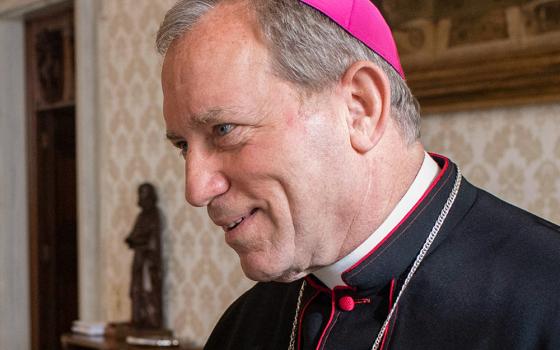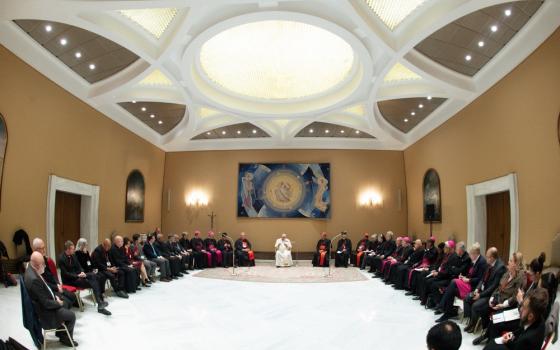Those who base their homilies on today’s Gospel pericope are actually homilizing on a homily.
Christians once presumed the Gospels were Jesus biographies: day-by-day eyewitness accounts of what this Galilean carpenter said and did during his public ministry. The Pontifical Biblical Commission drove the final stake through the heart of the biography option in 1964. Asked by the bishops of the Second Vatican Council to provide some general rules for interpreting the historicity of Gospels, the scholars eventually published a document titled “On the Historicity of Gospels.” Among other things, the commission insisted that, when reading the four Gospels, we be aware of the three stages that went into their formation.
|
 Most Christians posit two, not three stages: the “historical Jesus,” then the written Gospels. But it’s not quite that simple. The historical Jesus lived somewhere between 6 B.C. and 30 A.D.; our Gospels were composed between 70 and 95 A.D. During the 40 years between these two events, Jesus was preached. That means our evangelists got much of their material not from the historical Jesus, but from early Christian preachers. None of the four evangelists had ever come into contact with the historical Jesus.
Most Christians posit two, not three stages: the “historical Jesus,” then the written Gospels. But it’s not quite that simple. The historical Jesus lived somewhere between 6 B.C. and 30 A.D.; our Gospels were composed between 70 and 95 A.D. During the 40 years between these two events, Jesus was preached. That means our evangelists got much of their material not from the historical Jesus, but from early Christian preachers. None of the four evangelists had ever come into contact with the historical Jesus.
An old Latin proverb was at work in all three stages: Quidquid recipitur ad modum recipientis recipitum est. “Whatever is received is received only in as far as the person receiving it is capable of receiving it.”
The historical Jesus, for instance, spoke Aramaic because his audiences spoke Aramaic. The written Gospels, on the other hand, were composed in Greek because the communities they were written for spoke Greek. The same holds true for the church’s early preachers. Each proclaimed his or her message in the language of the audience being addressed.
But it is evident that preachers and evangelists changed more than Jesus’ language. One example: Mark’s Jesus says a man may not divorce his wife; a wife may not divorce her husband. But in Matthew, only the man may not divorce his wife; wives seem to be off the hook.
Scholars presume Matthew’s version can be traced back to the historical Jesus. During Jesus’ lifetime, Jewish women were never permitted to divorce their husbands. Since Matthew writes for a Jewish/Christian community, he can deliver Jesus’ words exactly as he pronounced them. On the other hand, the preachers on whom Mark depends are active in places in which women have the right to divorce. Jesus’ words are changed because the audience changes.
Though we can understand the process, many today fear altering anything the historical Jesus said. His words are sacrosanct.
We must also be aware that the Jesus about whom these second- and third-generation Christians wrote wasn’t the historical Jesus; it was the risen Jesus, the Jesus they were experiencing in their daily lives. As Paul put it, they believed the risen Jesus was a “new creation,” living and working in the culture and world of their day and age. He wasn’t just a resuscitated historical Jesus.
This conviction governed the way they changed or even added to his historical words. The risen Jesus’ late-first-century disciples dealt with questions and situations the historical Jesus never encountered. They couldn’t just fall back on “tradition.” They zeroed in on the risen Jesus’ presence in their midst. More than anything, his Spirit -- the one he had promised and sent -- helped them formulate their answers. God’s word was a living, vibrant, evolving entity.
Remember Jesus’ Last Supper words in John 16:12-15: “I have much more to tell you, but you cannot bear it now. When he comes, the Spirit of truth, he will guide you to all truth.” The evangelist believes that Jesus’ revelation about himself and the Father extends far beyond Jesus’ public ministry. The risen Jesus -- through the Holy Spirit --is still revealing “stuff” to and through his followers in stages two and three, and even down to our own day and age.
This process also applied to the Eucharist. In the earliest eucharistic references in 1 Corinthians, the emphasis is on the community. Though John stresses the community in his foot-washing narrative, he adds a new dimension: an emphasis on the actual bread and wine.
He first shows the superiority of Jesus’ eucharistic feeding to the story of the manna feeding in Exodus, then concentrates on the “true food” and “true drink” aspect of the eucharistic elements. (Without this specific Johannine reflection we’d probably have no tabernacles in our churches.)
Though our faith ancestors eventually recognized divine inspiration in this new eucharistic theology, they also chose to include it in a collection containing theologies that approach the breaking of bread from other points of view.
No wonder there were no catechisms in the early church.
[Roger Vermalen Karban is a priest of the Belleville, Ill., diocese and pastor of Our Lady of Good Counsel Parish in Renault, Ill.]




